 |
 |
| Project
Summary: Mary Isaak Center
OWNER/DEVELOPER
Committee on the Shelterless (COTS)
ARCHITECT
Kodama Diseno
LANDSCAPE
ARCHITECT
David Haslewood
CONTRACTOR
Midstate Construction Corporation PROPERTY
MANAGEMENT
Committee on the Shelterless (COTS)
| FUNDERS: |
TYPE: |
| California Dept. of Housing and Community Developement Division of Community Affairs |
Loan |
| Emergency Housing & Assistanace Program (EHAP) |
Loan |
| HUD Emergency Shelter Department) |
Grant |
| City of Petaluma |
Various Funds, e.g. Permit Fees, City Property Lease, Development Funds |
DEVELOPMENT
TYPE:
New construction homeless shelter
RESIDENT
PROFILE:
Homeless individuals
DENSITY: Not applicable, facility can house up to 134 individuals.
DEVELOPMENT
PROFILE
| Type |
#/Units |
Size
(sf) |
Rent |
| Dormitory Area |
n/a |
2,600 |
n/a |
| Shared Rooms |
14 |
170 sf |
n/a |
| Total |
accomodates 134 individuals |
|
|
Laundry: Common laundry
Courtyard/play: Day room and common room
Parking: 40 spaces
Total site area: 1.37 acres (59,876 sf) |
CONSTRUCTION
TYPE
Three storey wood frame.
DEVELOPMENT
COSTS:
Land cost: $440,000 (Land Development Cost); Constr. costs:
$3,200,000; Other costs: not applicable; Total
development costs: $3,640,000;
Completed in 2004. |
|
|
Mary Isaak Center - Petaluma, California
Green Features
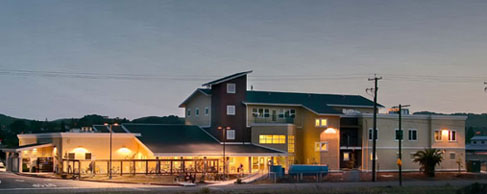
Mary Isaak Center is a unique facility designed to serve the needs of the homeless and to act as a beacon of hope for the neighborhood. The Center provides emergency shelter in a dormitory setting for those in need of immediate assistance, a dayroom and courtyard spaces for social interaction off the streets, shared rooms for individuals transitioning to permanent housing, a dining room, meeting rooms for supportive services and space for medical treatment. The Center is based on the premise that helping homeless individuals of the community is a dignified civic responsibility. Mary Isaak Center has the hopeful perspective that homelessness will eventually end and that their Center will be used for other civic activities.
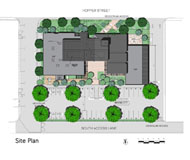 The project site is an existing brownfield in an industrial area slated for mixed-use redevelopment. The Center has a nominal fee long-term lease on their property with the City of Petaluma. As the first community–type building in this redevelopment area, the Mary Isaak Center has set the standard for future development by creating a high quality project that is responsive to the region’s rural and industrial context.
The project site is an existing brownfield in an industrial area slated for mixed-use redevelopment. The Center has a nominal fee long-term lease on their property with the City of Petaluma. As the first community–type building in this redevelopment area, the Mary Isaak Center has set the standard for future development by creating a high quality project that is responsive to the region’s rural and industrial context.
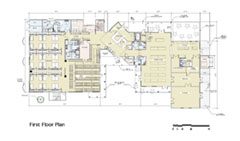 During the Center’s integrated design process many issues arose regarding the attitudes, both real and perceived, of the surrounding community toward this type of facility. The process included numerous meetings with the local government, community groups and potential future users. Because the facility is the first of its kind – combining supportive services, emergency housing, community kitchen/meals programs, transitional housing and offices into a single building –extensive research was done by the design team on facilities serving the homeless in the San Francisco Bay area. This included a comprehensive battery of case studies, site visits and program analyses. Using this information, design sessions were conducted with staff, representatives from the community, potential residents and other users. The design continued to evolve as issues of community image, sustainability, functionality, and security were considered. This collaborative iterative approach helped create a building in which the community now takes enormous pride. During the Center’s integrated design process many issues arose regarding the attitudes, both real and perceived, of the surrounding community toward this type of facility. The process included numerous meetings with the local government, community groups and potential future users. Because the facility is the first of its kind – combining supportive services, emergency housing, community kitchen/meals programs, transitional housing and offices into a single building –extensive research was done by the design team on facilities serving the homeless in the San Francisco Bay area. This included a comprehensive battery of case studies, site visits and program analyses. Using this information, design sessions were conducted with staff, representatives from the community, potential residents and other users. The design continued to evolve as issues of community image, sustainability, functionality, and security were considered. This collaborative iterative approach helped create a building in which the community now takes enormous pride.
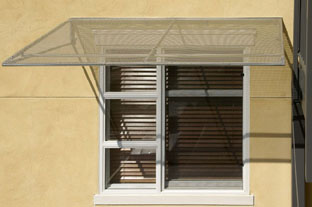 For maximum energy efficiency, the project was designed considering solar access and natural ventilation. Its long axis is oriented east-west to maximize southern exposure and harness the site’s considerable prevailing winds. A 12” thick concrete finish floor provides thermal mass to reduce temperature extremes. Overhanging roofs and window awnings provide shade in the summer but allow solar heat gain in winter. Trees shade the occasional west-facing windows. In addition to shading, high performance windows help minimize summer heat gain. All these measures allow the mechanical system to work in concert with passive strategies and primarily be used for supplemental heating. When cooling is needed, the system uses an evaporative system rather than air conditioning and is 5% more efficient than required by California’s Title 24 energy code. The project was designed in anticipation of future solar hot water heating for which funding has been secured. For the unfinished third floor, the project team is designing a hybrid heating system that will incorporate energy efficient, green features. For maximum energy efficiency, the project was designed considering solar access and natural ventilation. Its long axis is oriented east-west to maximize southern exposure and harness the site’s considerable prevailing winds. A 12” thick concrete finish floor provides thermal mass to reduce temperature extremes. Overhanging roofs and window awnings provide shade in the summer but allow solar heat gain in winter. Trees shade the occasional west-facing windows. In addition to shading, high performance windows help minimize summer heat gain. All these measures allow the mechanical system to work in concert with passive strategies and primarily be used for supplemental heating. When cooling is needed, the system uses an evaporative system rather than air conditioning and is 5% more efficient than required by California’s Title 24 energy code. The project was designed in anticipation of future solar hot water heating for which funding has been secured. For the unfinished third floor, the project team is designing a hybrid heating system that will incorporate energy efficient, green features.
A 21kW photovoltaic array at Mary Isaak center is projected to provide 40% of the facility’s electricity. The system is net metered, allowing the Center to sell unneeded energy back to the local utility. Electric loads at the Center are kept in check with Energy Star appliances, daylighting, daylighting controls and occupancy sensors. Exterior lighting features full cut-off fixtures ( a light fixture that doesn’t allow light or glare above a horizontal plane from the base of the fixture) to reduce light pollution and conserve energy.
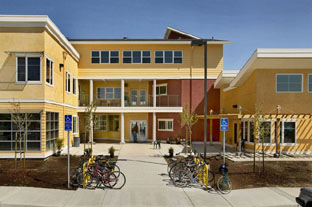 The project team worked hard to minimize the number of parking spaces on site and to shade those that are provided with trees. Working closely with City officials and the local bicycle committee, consensus was reached in allowing modest vehicular parking while incorporating bicycle-related improvements on site, such as numerous bike racks, a designated bicycle repair area and a pit stop for community bicyclists. For the vast majority of residents at Mary Isaak, bicycles are the primary form of transportation. Approximately 10 minutes from the city center by bicycle, the project design includes plans for a future bicycle path to link to local thoroughfares. Once a road extension crossing the adjacent railroad tracks is completed, the project will be a short walk to the nearest bus stop. The project team worked hard to minimize the number of parking spaces on site and to shade those that are provided with trees. Working closely with City officials and the local bicycle committee, consensus was reached in allowing modest vehicular parking while incorporating bicycle-related improvements on site, such as numerous bike racks, a designated bicycle repair area and a pit stop for community bicyclists. For the vast majority of residents at Mary Isaak, bicycles are the primary form of transportation. Approximately 10 minutes from the city center by bicycle, the project design includes plans for a future bicycle path to link to local thoroughfares. Once a road extension crossing the adjacent railroad tracks is completed, the project will be a short walk to the nearest bus stop.
A planned vegetable and herb garden will be located on the building’s south side. When the garden matures, it is intended that produce and herbs grown on site may someday supplement the meals provided to residents and the community through the hot meals program. The project uses drought resistant landscaping and employs irrigation reduction. Bathrooms contain waterless urinals. Since the site is located in an industrial area adjacent to water treatment facilities, the team concentrated on water conservation, rather than retaining or reusing water.
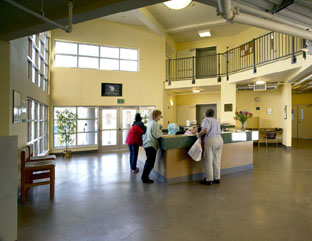 The project team prioritized resource conservation to be green and in some cases to save money. Recycled content materials include engineered wood products, fly ash concrete, fiberglass insulation with a minimum 25% recycled content, and High Density Polyethylene (HDPE) toilet and shower compartments made with a minimum of 50% recycled material. Money was saved in the many spaces where the structural concrete floor slab serves as the finish floor. This saved materials and allows the slab to act more effectively as a thermal mass. The concrete for the project is from a plant that is less than 1/4 mile away. A recycling area designated for boxes and palettes is on site and a large storage area accommodates the re-use of goods donated to the facility. For improved indoor air quality, formaldehyde free fiberglass insulation, linoleum flooring and low VOC paints were used. The project team prioritized resource conservation to be green and in some cases to save money. Recycled content materials include engineered wood products, fly ash concrete, fiberglass insulation with a minimum 25% recycled content, and High Density Polyethylene (HDPE) toilet and shower compartments made with a minimum of 50% recycled material. Money was saved in the many spaces where the structural concrete floor slab serves as the finish floor. This saved materials and allows the slab to act more effectively as a thermal mass. The concrete for the project is from a plant that is less than 1/4 mile away. A recycling area designated for boxes and palettes is on site and a large storage area accommodates the re-use of goods donated to the facility. For improved indoor air quality, formaldehyde free fiberglass insulation, linoleum flooring and low VOC paints were used.
Lessons Learned from the architect - Upfront education of the design team and contractor is essential for success in installation of 'new' installation requirements or techniques. Making sure the requirements are clearly indicated in the documents by the team, and calling the contractor's attention to them will help avoid problems in the field, i.e., the prevention of surface hairline cracks in high fly-ash content concrete.
It pays to discuss 'out of the box' ideas; in our case, the lack of extra floor finish over concrete actually was more cost effective and preferred for ease of maintenance.
In our case planning ahead to separate discrete systems out of the main construction contract for implementation at a later date (when funding has been obtained) was a successful strategy for solar hot water and photovoltaics. Planning for future systems by planning for future equipment locations, allowing for adequate pipe sizing and stubbing out for future work were successful strategies.
Working with the Owner in considering anticipated time of day/hours of peak building usage and temperature/comfort levels at those times helped avoid excess mechanical systems.
Some of the most important features often do not add extra cost: taking care in preliminary building orientation, designing exterior spaces as rooms, locating windows for optimal ventilation.
Design team's dedication to 'green' vision is the driving force for saving core systems and materials when value engineering forces cost cutting measures in the design.
Initial and continued full support from all senior decision makers through completion of the project is vital.
Contract language should clearly spell out “green/sustainable” goals which have been established.
Inform your client about rebate programs, grants, tax credits, and financial incentives, which are made available for green/sustainable projects.
Go with a team that has a record of green projects and push their envelope on creativity.
Lock all green building components into the budget and specifications.
Green Features
Click here to see the AIA Affordable Green Guidelines
|
Mary Isaak Center
|
| Use of Brownfield |
The project site is an existing brownfield in an industrial area slated for mixed-use redevelopment. |
| Access to Public Transportation |
Once a road extension crossing the adjacent railroad tracks is completed, the project will be a short walk to the nearest bus stop.
|
| Compact Development |
The project density can house up to 134 individuals. Units per acre does not apply.
|
| Passive Heating and/or Cooling |
The project was designed considering solar access and natural ventilation. Its long axis is oriented east-west to maximize southern exposure and harness the site’s considerable prevailing winds. A 12” thick concrete finish floor provides thermal mass to reduce temperature extremes. Overhanging roofs and window awnings provide shade in the summer but allow solar heat gain in winter. Trees shade the occasional west-facing windows. |
| Daylighting |
Windows allow for ample daylighting, daylighting controls coordinate electric light with daylighting. |
| High Performance WIndows |
Vinyl frame double glazed low e windows. |
| Energy Efficiency Heating and Cooling |
Evaporative cooling is used rather than air conditioning is 5% more efficient than required by California’s Title 24 energy code. |
| Energy Star Appliances/Lighting |
All units are equipped with Energy Star Appliances. |
| Renewable Energy |
A 21kW photovoltaic array at Mary Isaak center is projected to provide 40% of the facility’s electricity. The system is net metered, allowing the Center to sell unneeded energy back to the local utility. |
| Water Efficient Landscaping |
The project uses drought resistant landscaping and employs irrigation reduction. |
| Water Saving Appliances |
Bathrooms contain waterless urinals. |
| Local Materials |
Concrete for the project came from a plant within 1/4 mile of the site. |
| Recycled Content Materials |
Engineered wood products, fly ash concrete, fiberglass insulation with a minimum 25% recycled content, and High Density Polyethylene (HDPE) toilet and shower compartments made with a minimum of 50% recycled material. |
| Low VOC Materials |
Formaldehyde free fiberglass insulation, linoleum flooring and
low VOC paints were used. |
|



 For maximum energy efficiency, the project was designed considering solar access and natural ventilation. Its long axis is oriented east-west to maximize southern exposure and harness the site’s considerable prevailing winds. A 12” thick concrete finish floor provides thermal mass to reduce temperature extremes. Overhanging roofs and window awnings provide shade in the summer but allow solar heat gain in winter. Trees shade the occasional west-facing windows. In addition to shading, high performance windows help minimize summer heat gain. All these measures allow the mechanical system to work in concert with passive strategies and primarily be used for supplemental heating. When cooling is needed, the system uses an evaporative system rather than air conditioning and is 5% more efficient than required by California’s Title 24 energy code. The project was designed in anticipation of future solar hot water heating for which funding has been secured. For the unfinished third floor, the project team is designing a hybrid heating system that will incorporate energy efficient, green features.
For maximum energy efficiency, the project was designed considering solar access and natural ventilation. Its long axis is oriented east-west to maximize southern exposure and harness the site’s considerable prevailing winds. A 12” thick concrete finish floor provides thermal mass to reduce temperature extremes. Overhanging roofs and window awnings provide shade in the summer but allow solar heat gain in winter. Trees shade the occasional west-facing windows. In addition to shading, high performance windows help minimize summer heat gain. All these measures allow the mechanical system to work in concert with passive strategies and primarily be used for supplemental heating. When cooling is needed, the system uses an evaporative system rather than air conditioning and is 5% more efficient than required by California’s Title 24 energy code. The project was designed in anticipation of future solar hot water heating for which funding has been secured. For the unfinished third floor, the project team is designing a hybrid heating system that will incorporate energy efficient, green features.  The project team worked hard to minimize the number of parking spaces on site and to shade those that are provided with trees. Working closely with City officials and the local bicycle committee, consensus was reached in allowing modest vehicular parking while incorporating bicycle-related improvements on site, such as numerous bike racks, a designated bicycle repair area and a pit stop for community bicyclists. For the vast majority of residents at Mary Isaak, bicycles are the primary form of transportation. Approximately 10 minutes from the city center by bicycle, the project design includes plans for a future bicycle path to link to local thoroughfares. Once a road extension crossing the adjacent railroad tracks is completed, the project will be a short walk to the nearest bus stop.
The project team worked hard to minimize the number of parking spaces on site and to shade those that are provided with trees. Working closely with City officials and the local bicycle committee, consensus was reached in allowing modest vehicular parking while incorporating bicycle-related improvements on site, such as numerous bike racks, a designated bicycle repair area and a pit stop for community bicyclists. For the vast majority of residents at Mary Isaak, bicycles are the primary form of transportation. Approximately 10 minutes from the city center by bicycle, the project design includes plans for a future bicycle path to link to local thoroughfares. Once a road extension crossing the adjacent railroad tracks is completed, the project will be a short walk to the nearest bus stop.  The project team prioritized resource conservation to be green and in some cases to save money.
The project team prioritized resource conservation to be green and in some cases to save money.